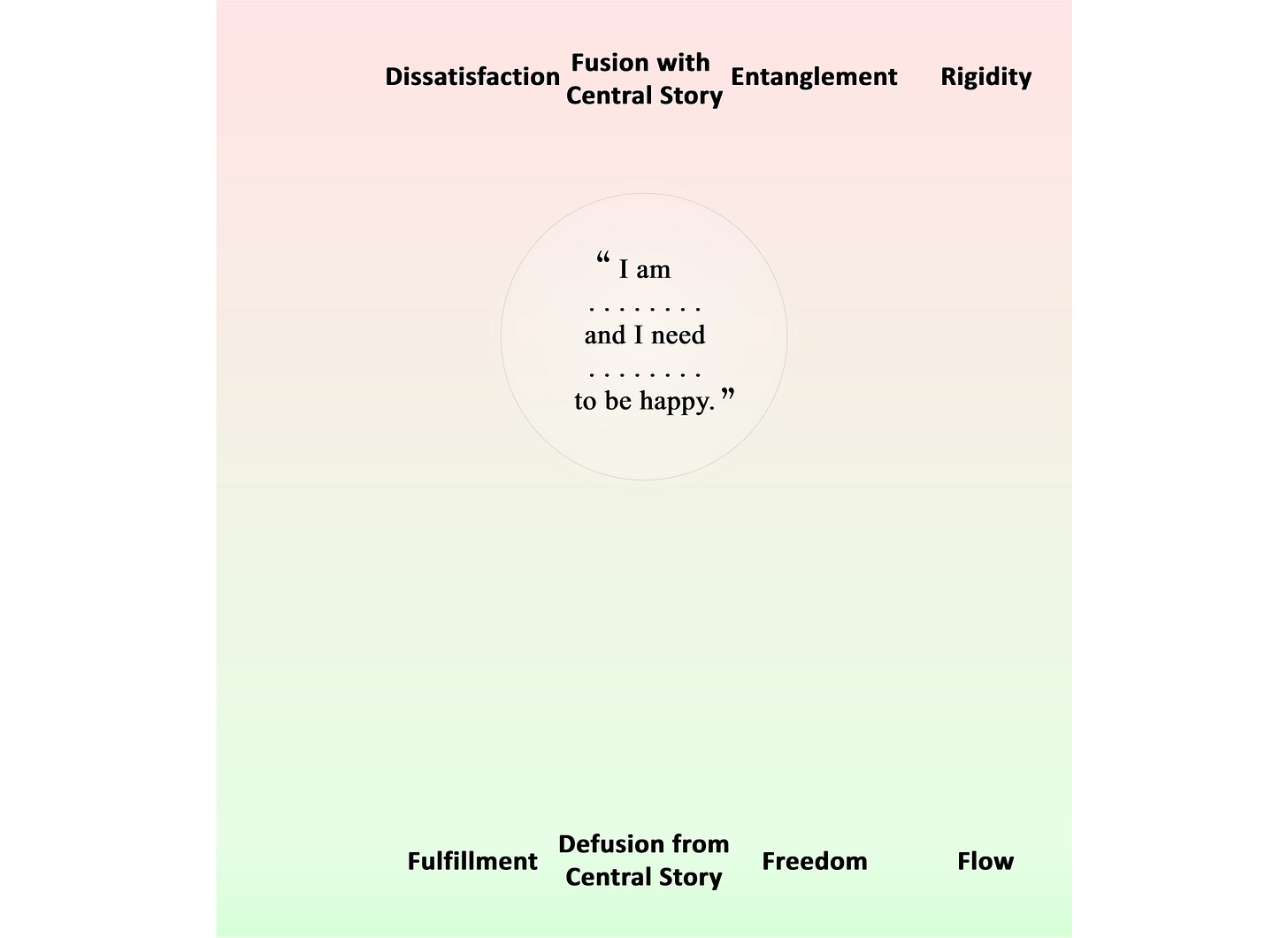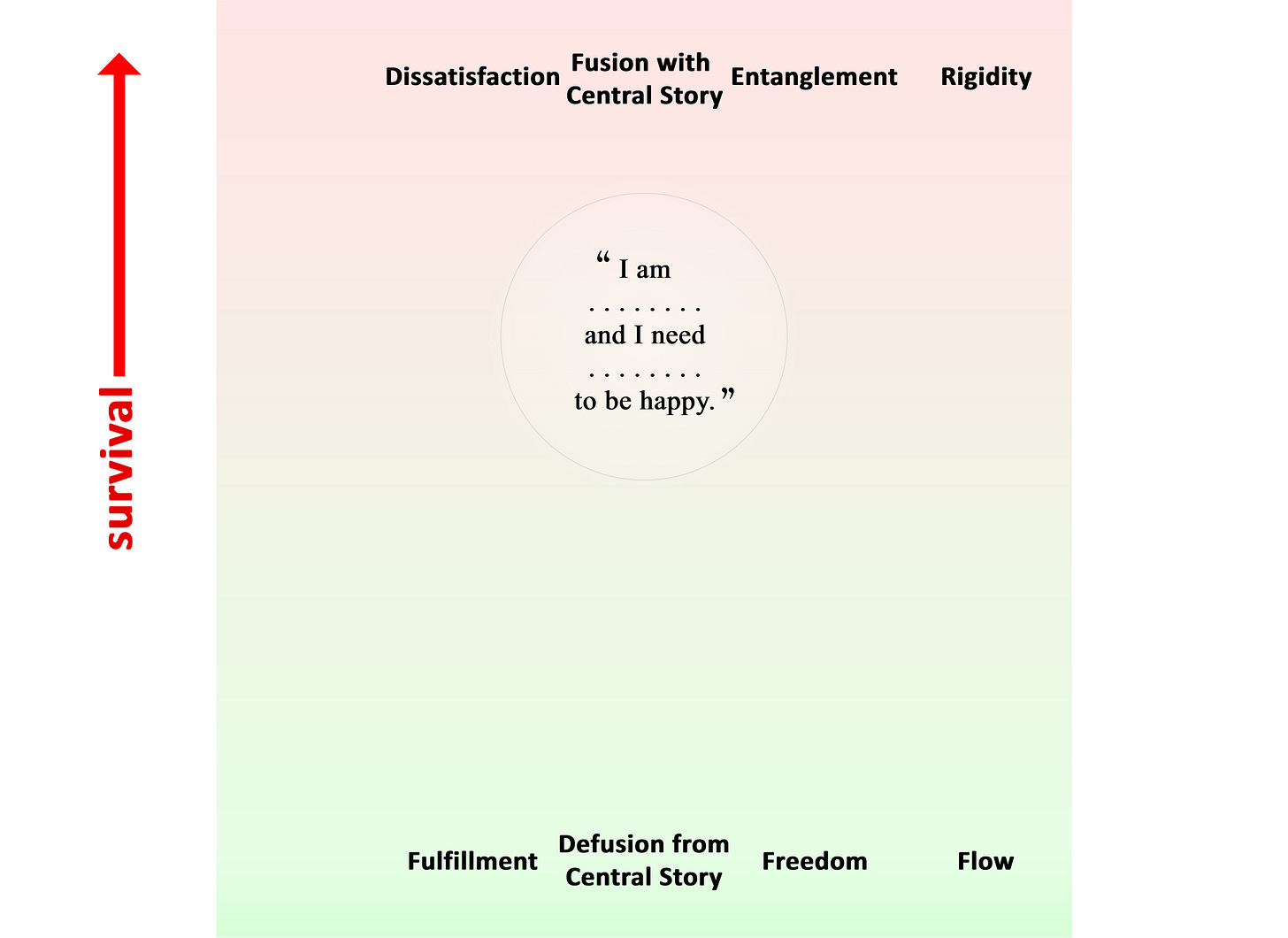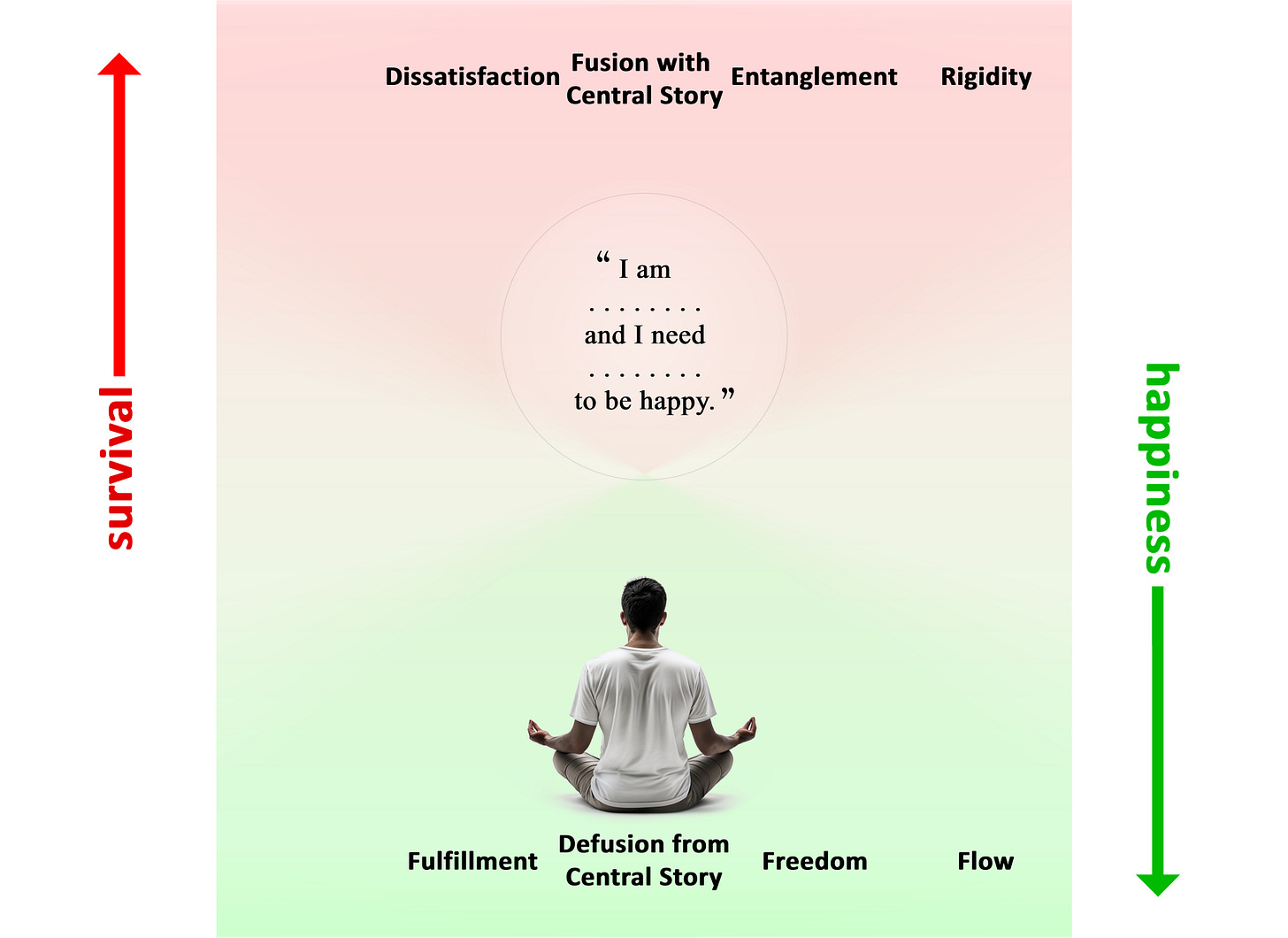Hi friend,
The Central Story Model is my guide to effective meditation and the theoretical framework behind Central Story Training. According to the Central Story Model, at the center of our experience is a story, the “Central Story”, that says, “I am …….. and I need …….. to be happy”1.
What is your Central Story saying right now? (Fill in the dots.)
For example, right now your Central Story might be saying, “I am confused and I need you to explain better to be happy” 🤨 or “I am intrigued and I need to keep reading to be happy” 🤓
You could also think of your Central Story as your Central Sense, the unspoken sense that,
You are this or that — for example, your body, your sensations, your thoughts, or your state of consciousness.2
You need something else to be happy — for example, you need to stop experiencing an unpleasant feeling, you need the present situation to change, you need someone to act differently, or you need to get to a certain place in the future.
Can you become and remain aware of your Central Sense right now?
You can do this not by effort, but by opening your mind and letting go.
According to the Central Story Model, the more our attention is fused into our Central Story — meaning the more we believe our Central Story and perceive the present moment as depicted by it — the more we experience dissatisfaction, entanglement, and rigidity.
Inversely, the more our attention is defused from our Central Story — meaning the more we cognitively step back from our Central Story and perceive it as only a story, a small part of our present experience — the more we experience fulfillment, freedom, and flow.
As you may have noticed, the default movement of our attention is a movement toward fusion with the Central Story and therefore dissatisfaction, entanglement, and rigidity. I will unpack this in a future article, but this is perfectly normal and has to do with the fact that our nervous system is hardwired to move our body toward survival.
A therapeutic movement of our attention is a movement toward defusion from the Central Story and therefore fulfillment, freedom, and flow. It is a movement toward happiness, and it is this movement that we try to create with meditation.
The top and bottom mental qualities are not black and white but on a continuum, and they always go together, at the same intensity. What the Central Story Model predicts, which I invite you to check in your personal experience, is that, for instance, in a moment when our cognitive fusion with our Central Story is at a 8/10, our dissatisfaction, entanglement, and rigidity will also be at a 8/10; in a moment when our sense of flow is at a 6/10, our fulfillment, defusion from our Central Story, and freedom will also be at a 6/10. These qualities go together, at the same intensity. In other words, our mental state fluctuates up and down the continuum of the Central Story Model.
To enrich our model, I will add more qualities and give you the complete Central Story Model, which you can print here.
I will now describe each of these qualities. As you read the following descriptions, please see how they resonate with your experience.
Top qualities:
Narrowness — We hyperfocus on one or a few objects at the exclusion of the rest of the present moment. (Alternate words: contraction, zooming in, fixation.)
Heaviness — Our mind holds onto and is burdened by things. (Alternate words: weightiness, stickiness.)
Division — We experience a strong sense of separation between us and the world; pleasure and pain; likes and dislikes; problems and solutions; past, present, and future. (Alternate words: duality, separation, preferences.)
Agitation — We are tossed around by thoughts. (Alternate word: restlessness.)
Dissatisfaction — The present moment feels wrong, flawed, not good enough. (Alternate words: ill-being, discontentment, unhappiness.)
Fusion with the Central Story — We believe the Central Story (“I am …….. and I need …….. to be happy”) to be undeniably true. (Alternate words: identification, desire, attachment.)
Entanglement — We feel trapped in the content of our experience. (Alternate words: entrapment.)
Rigidity — We perceive phenomena as solid, well-defined entities that collide and conflict with each other. (Alternate word: reification.)
Resistance — We psychologically resist the presence or natural movement of certain aspects of the present moment. (Alternate words: struggle, avoidance, repression.)
Rumination — We overthink. (Alternate words: compulsive thinking, excessive thinking.)
Imagination — We daydream about the past, the future, or fictional scenarios of how things could or should be. (Alternate words: fantasy.)
Bottom qualities:
Spaciousness — Our attention is spacious and encompasses everything in the present moment. (Alternate word: openness, zooming out, peripheral awareness.)
Lightness — Our mind is not attached to or burdened by anything. (Alternate words: weightlessness, non-stickiness.)
Unification — We see no real separation between us and the world; pleasure and pain; likes and dislikes; problems and solutions; past, present, and future. (Alternate words: non-duality, non-separation, non-preferences.)
Peace — We are not tossed around by thoughts. (Alternate words: safety, ease, tranquility.)
Fulfillment — We experience a deep sense of contentment with the way things are in the present moment. (Alternate word: well-being, contentment, plenitude, love, bliss.)
Defusion from the Central Story — We see the Central Story (”I am …….. and I need …….. to be happy”) as just a story, a small part of our experience. (Alternate words: non-identification, non-desire, non-attachment.)
Freedom — Our attention is not caught in any aspect of our experience. (Alternate word: unbinding.)
Flow — We see how everything is alive and changing in the present moment. (Alternate words: circulation.)
Acceptance — We psychologically accept, welcome, and make space for the presence and movement of everything in the present moment. (Alternate words: equanimity, tolerance, non-resistance.)
Silence — Our mind is quiet. (Alternate words: quietude, stillness.)
Presence — We are aware of sights, sounds, smells, tastes, and physical sensations. (Alternate words: awareness, mindfulness, direct cognition.)
In future articles, I will explain the many ways in which the Central Story Model can support your meditation practice, but for now, the most important takeaway is this: whatever technique you are using, you want to make sure it is helping you to experience more spaciousness, lightness, unification, peace, fulfillment, defusion from the Central Story (“I am …….. and I need …….. to be happy”), freedom, flow, acceptance, silence, and presence.
If the meditation technique you are practicing is not helping you do so, I invite you to either tweak your technique or practice another technique.
You could also think of your Central Story as saying, “I am …….. and I need ……..”, “I am …….. and I want ……..”, “I have …….. and I need …….. to be happy”, “I have …….. and I need ……..”, or, “I have …….. and I want ……..”.
Or you own this or that — eg. your loved ones, your house, or your car.










